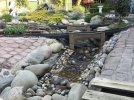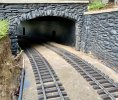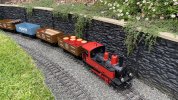Currently, I have 3 different types of base on my railroad:
1. When laying directly onto a flat concrete base (e.g. cinder blocks), is there any benefit to adding ballast? For example, this post shows track layed directly onto the blocks, although there is ballast in the background of one of the pictures. If the concrete is supporting the track, does ballast do anything more than give it a realistic appearance?
2. As an alternative, lets say I have a concrete foundation but actually want to use gravel ballast to support the track. That is, the ballast will go under and around the track, not just fill in the gaps. I had previous dug a ditch, lined the sides, and filled it with about 10cm of gravel. The track seems fine, but I'm getting a lot of issues with plants over-growing and running weeds putting roots down through the gravel. I was thinking instead of using a concrete underlay with only 1-2cm of gravel to smooth out the surface.
Is this workable?
If I need to lay the concrete so that in places the track is elevated above ground level, are there any tricks to getting a "channel" in the concrete so the gravel stays where it should?
My rationale for laying concrete + ballast is that ballast makes the concrete base more forgiving, as it smooths out any irregularities in the concrete (rough surfaces or imperfect levelness), whereas its quite a bit of work to get either cinder blocks laid evenly (and there are gaps around curves for weeds to grow in) or to lay concrete with a perfectly smooth surface. And the concrete base blocks weeds from growing up.
Guidance welcome.
- Elevated wooden panels (not exactly bridges)
- Cinder blocks
- Trenches filled with gravel
1. When laying directly onto a flat concrete base (e.g. cinder blocks), is there any benefit to adding ballast? For example, this post shows track layed directly onto the blocks, although there is ballast in the background of one of the pictures. If the concrete is supporting the track, does ballast do anything more than give it a realistic appearance?
2. As an alternative, lets say I have a concrete foundation but actually want to use gravel ballast to support the track. That is, the ballast will go under and around the track, not just fill in the gaps. I had previous dug a ditch, lined the sides, and filled it with about 10cm of gravel. The track seems fine, but I'm getting a lot of issues with plants over-growing and running weeds putting roots down through the gravel. I was thinking instead of using a concrete underlay with only 1-2cm of gravel to smooth out the surface.
Is this workable?
If I need to lay the concrete so that in places the track is elevated above ground level, are there any tricks to getting a "channel" in the concrete so the gravel stays where it should?
My rationale for laying concrete + ballast is that ballast makes the concrete base more forgiving, as it smooths out any irregularities in the concrete (rough surfaces or imperfect levelness), whereas its quite a bit of work to get either cinder blocks laid evenly (and there are gaps around curves for weeds to grow in) or to lay concrete with a perfectly smooth surface. And the concrete base blocks weeds from growing up.
Guidance welcome.





